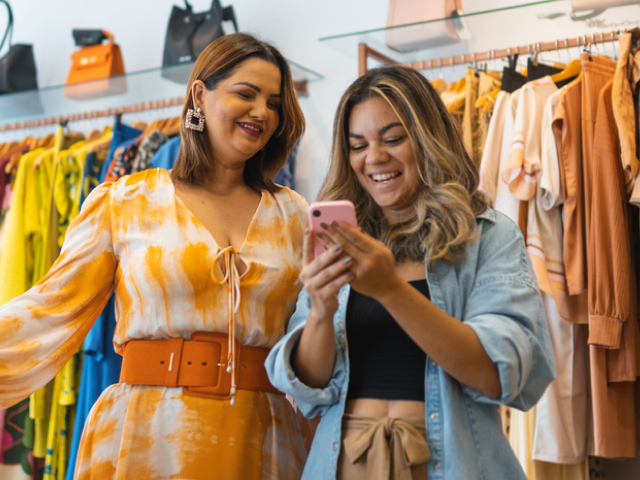Consumers are poised to increase in-store spend across all retail categories as we ease pandemic restrictions and transition towards economic re-opening. Recently, McKinsey found that over half of all US consumers plan to spend extra to treat themselves as part of a post-pandemic return to normal, with specific intention to spend in discretionary categories. This is particularly pronounced among those who have been vaccinated and can be expected to continue as vaccination rates increase.
While this is a clear signal to retailers that pent-up demand is set to impact store sales, there were new customer behaviors forged during the lockdowns, which are expected to remain in place as a return to in-store shopping continues. The most notable long-term impact on consumer behavior is an expected ‘digital stickiness’, or intention to continue using technological tools that were adopted during lockdown. McKinsey expects this digital stickiness to play an outsized role in purchase behavior moving forward.
Many of the digital tools that retailers deployed were stop-gap measures intended to ensure business continuity by providing transaction and fulfillment options while stores were shuttered. However, the post-pandemic consumer has been molded by the convenience and accessibility afforded by these tools and expects a true omnichannel experience that incorporates these services as part of the return to in-store shopping. Providing a customer journey that incorporates these newly adopted behaviors as part of an omnichannel experience will be critical in retailers’ bid to establish a competitive advantage in post-pandemic retail.
Flexibility meets speed
Flexible, fast retail fulfillment options such as curbside pickup, Buy Online Pickup In Store (BOPIS), and Reserve Online Pickup In Store (ROPIS) are among the most defining shifts in consumer behavior due to pandemic restrictions, and are set to have a lasting impact on post-pandemic retail. According to Google, searches for curbside pickup solutions increased 3,000% between May 2019 and May 2020 and searches for “available near me” increased 100% globally over the last year. Now that customers have experienced the convenience of fast and local fulfillment options, and these new habits have had enough time to become firmly entrenched purchase patterns, retailers can anticipate that customers will expect flexible, fast fulfillment options to continue into post-pandemic life.
Looking to the future, how fulfilment options are offered, processed and tracked need to be implemented as more than stop-gap measures, as was typically the case during the rapidly evolving pandemic environment. Instead, the post-pandemic omnichannel purchase journey will need to be reassessed to ensure fast and flexible fulfillment options are made available across customer touchpoints to align with customer expectations.
Omni-connection
When the pandemic hit there was a near overnight shift to replace in-person interactions with virtual interactions to align with social distancing requirements. In response to this, and in an effort to maintain customer relationships that had been nurtured over years, retailers harnessed new tools such as video shopping and web chat. Alongside this, new initiatives such as Instagram Live shopping experiences, virtual events, and virtual fashion shows were experimented with in an effort to connect with a new cohort of consumers.
Now that restrictions are easing and customers are re-entering the store, Bain & Company reported that one of consumers’ top priorities coming out of the pandemic is feeling connected. However, returning to a pre-pandemic operating model of predominantly in-store passive communications is no longer feasible now that customers have become used to and expect a fast, open and direct line of communication with their favorite brands. This represents an opportunity for retailers to introduce an omnichannel communication experience that leverages both pre- and post-pandemic communication tools as part of their reopening return to business. The digital tools that were seen as mission critical during pandemic restrictions, such as remote pay and appointment-based shopping, should be incorporated into a refreshed customer journey. Incorporating tools that support new behaviors alongside a desire for traditional connection will allow retailers to most effectively capitalize on pent-up demand for discretionary items during the initial phases of re-opening, and also deliver on consumer expectations into the future.
Indifference replaces loyalty
One of the strongest headwinds facing retailers as the economy reopens and customers return to stores is an erosion to the loyalty felt by customers towards brands and retailers. According to McKinsey, consumers’ willingness to sample new brands and digital shopping methods over the course of the pandemic led to this erosion of brand loyalty, and as a result, consumers are re-entering the marketplace equipped with new purchase behaviors and driven by a preference for convenience and value.
While this represents a challenge for retailers who endeavor to return to ‘business as usual’ it also presents an opportunity for innovative retailers to attract and retain new customers. Retailers can capitalize on this by offering an omnichannel experience that incorporates new consumer behaviors at a time when customers are actively treating themselves to discretionary items. This is particularly valuable during the ‘testing’ phase, when customers are re-entering the store and sampling new brands. During this phase, retailers can establish new loyalties by delivering a redesigned customer journey that aligns with new customer behaviors and expectations, ensuring a competitive edge and future loyalty.
It has become increasingly apparent that fundamental shifts in behavior, expectations and loyalties established during the pandemic are here to stay. Returning to pre-pandemic business as usual is no longer an option for retailers to compete in a redefined retail age. However, by embracing these changes and incorporating them into a true omnichannel experience that incorporates all customer touchpoints, retailers can establish a competitive advantage to not just survive in post-pandemic retail, but thrive.
This blog was written as first of three blogs series. Subscribe to our blog today to get latest updates.


